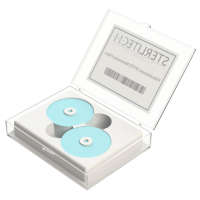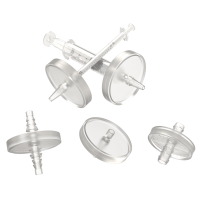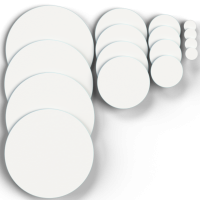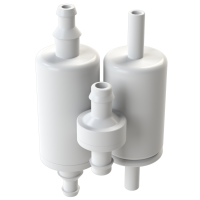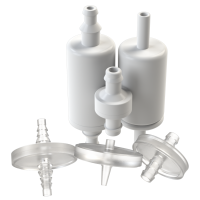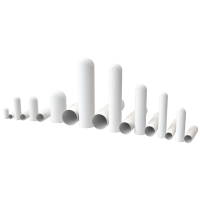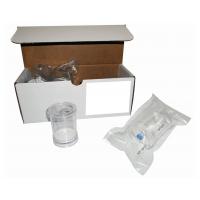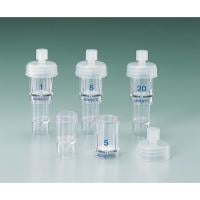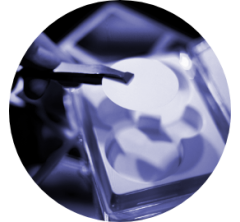Filters
Sterlitech’s comprehensive range of membrane, syringe, and capsule filters are exclusively selected to represent the industry’s highest quality manufacturing standards, product performance, and application support for laboratory-scale filtration.
Our filtration devices have been rigorously tested and optimized to reduce process times, increase analytical efficiency, and produce consistent, measurable results. We offer polymeric, glass fiber, and ceramic membranes--in all standard diameters and a range of pore sizes--as disc/sheet filters or housed within syringe and capsule devices for single-use applications. Sterile and non-sterile options are available, along with a multitude of other custom features to accommodate end-users' diverse needs.
 Frequently Asked Questions
Frequently Asked Questions
Q: How is the performance of a filter measured?
Q. How is the performance of a filter measured?
A. Design and material selection determines the performance of a filter. Three important measures of filter performance are flow rate, throughput and bubblepoint, defined as follows:
Flow Rate: Determines the volume of liquid or air that will flow through the filter at a fixed pressure and temperature. This is usually displayed as ml/minute/cm^2.
Throughput: Describes the dirt handling capacity of a filter. Namely, how long the liquid will continue to flow through the membrane before the membrane clogs. The lower the flow rate and throughput, the longer it takes the researcher to complete the analysis.
Bubble point: A test to determine the integrity and pore size of a filter. The differential pressure at which a steady stream of gas bubbles is emitted from a wetted filter under specific test conditions. The bubble point test measures the largest pore. Bubble point is generally determined using water or an alcohol (methanol or isopropynol) and is displayed as PSI.
Q: What variables affect the performance of a filter?
Q. What variables affect the performance of a filter?
A. Viscosity: The viscosity of a liquid determines its resistance to flow; the higher the viscosity, the lower the flow rate and the higher the differential pressure required to achieve a given flow rate.
Porosity: The flow rate of a membrane is directly proportional to the porosity of a membrane, eg. the more pores, the higher the flow rate.
Filter Area: The larger the filter area, the faster the flow rate at a given pressure differential and the larger the expected filter throughput volume prior to "clogging for a given solution."
Q: How are pore sizes rated?
Q. How are pore sizes rated?
A. A pore size rating is determined by the diameter of the particle that it can be expected to retain with a defined, high degree of efficiency. The rating is stated in nominal or absolute terms.
Q: How is pore size determined?
Q. How is pore size determined?
A. The pore size of a filter, normally stated in micrometers (µm), is determined by the diameter of a particle that is retained by the filter. This is determined using a challenge organism and/or bubble point testing.
Q: What is the maximum operating pressure for the Capsule filters?
Q. What is the maximum operating pressure for the Capsule filters?
A. The maximum operating pressure for the Capsule filters varies with liquids and gases.
Liquids - 80 psi
Gases - 55 psi
Q: How many times can the Capsule filters be autoclaved?
Q. How many times can the Capsule filters be autoclaved?
A. The Capsule filters can be autoclaved at 121°C for up to five 30 min cycles.
Q: What is a KD (kiloDalton)?
Q. What is a KD (kiloDalton)?
A. KD, or kD is the abbreviation for kiloDalton and is equal to 1,000 Molecular Weight Cut-Off (MWCO). A solution having a molecular weight of 1,000,000 would be equivalent to 1,000 KD. The table listed below gives a general relationship between kiloDalton to Microns (micrometers), Nanometers, and Angstroms:
| KD's | Microns | Nanometers | Angstroms |
| 1,000 KD | 0.1 micron | 100 | 1000 |
| 500 KD | 0.02 micron | 20 | 200 |
| 200 KD | 0.01 micron | 10 | 100 |
| 50 KD | 0.004 micron | 4 | 40 |
| 10 KD | 0.0025 micron | 2.5 | 25 |
| 5 KD | 0.0015 micron | 1.5 | 15 |
As a general rule, choose a membrane with a pore size (MWCO) that is less than half of the compound of interest.
Q: Can I filter aqueous solutions through a polytetrafluoroethylene (PTFE) hydrophobic membrane?
Q. Can I filter aqueous solutions through a polytetrafluoroethylene (PTFE) hydrophobic membrane?
A. Yes, but the membrane requires pre-wetting with alcohol (like Isopropanol or Methanol) to establish flow with reasonable pressure differentials. We often use a 60/40 solution (60 Isopropanol/ 40 water) to prewet the membrane.
Q: I am interested in gridded, sterile membranes, but I am concerned about the high costs of shipping Nitrocellulose internationally. Do you have other types of membranes that can be used?
Q. I am interested in gridded, sterile membranes, but I am concerned about the high costs of shipping Nitrocellulose internationally. Do you have other types of membranes that can be used?
A. We offer two alternatives to gridded Nitrocellulose membranes, which incur no Hazardous materials charges, Nylon and Polyethersulfone (PES).
Q: Can my Nylon membranes be treated exactly like Nitrocellulose during colony hybridization?
Q. Can my Nylon membranes be treated exactly like Nitrocellulose during colony hybridization?
A. One of our customers was wondering if drying E. coli on Nylon transfer membranes prior to denaturation effects the colony hybridization. Further, they were wondering if after drying the membranes, would treating with SDS before denaturation effect the hybridization? The answer is...NO, this will work! The hybridization will not be adversely affected. This is the procedure they used.
Procedure
- performed colony lifts
- air dried nylon membranes with E. coli
- incubated 3 minutes on 3MM paper saturated with 10% SDS.
- incubated 5 minutes on 3MM with 0.5M NaOH, 1.5 M NaCI.
- incubated 5 minutes on 3MM with 1.5 M NaCI, 0.5M Tris pH 7.5.
- incubated 5 minutes on 3MM with 2X SSC.
- UV crosslinked without drying.
- prehybridized and hybridized as usual.
Q: Which membrane is recommended for size characterization analysis?
Q. Which membrane is recommended for size characterization analysis?
A. The polycarbonate track-etch (PCTE) membrane is recommended for size characterization analyses. The pores of this membrane are exceptionally uniform and are offered as low as 0.01um in size.
Q: We would like to filter fluids and wonder which membrane to use for cytology?
Q. We would like to filter fluids and wonder which membrane to use for cytology?
A. Cytology:
Cells are removed from the body, then stained and examined under a microscopy. The trained physician or cytotechnologist is able to detect the presence of malignancy.
Use of either the 5.0 um or 8.0 um polycarbonate membrane.
- Pore Structure and Porosity
Minimum clogging by red blood cells and protein. Well preserved cellular morphology. High recovery rate. Rapid filtration with low pressure. Surface capture. No cover slip edge sealing.
- Smooth, Flat Surface
High cell visibility. Improved morphologic resolution. Surface capture.
- "Thinness"
Easy mounting. Immediate microscopic examination.
- Low absorption and adsorption
Improved contrast. Greater cell isolation. Easy mounting.
- Non-staining
Improved contrast. Simpler microscopic analysis routine.
- Transparency
Simpler microscopic analysis routine.
- Chemical Resistance
Unaffected by conventional cytologic fixatives and stains.
- Strength
Less critical handling techniques needed.
Equipment needed
25mm or 47mm filter holder
Stainless steel forceps
5.0um - 25mm or 47mm PCTE membranes
General Procedure - procedure may vary
Most body fluids contain blood in various amounts.
Collect them in a container with an anticoagulant.
One recommended using polycarbonate membranes is EDTA (0.1 molar)
For each 5-ml specimen generally 1 ml of EDTA solution is sufficient; for specimens of higher blood content, 1 ml of EDTA for each 20-ml specimen is recommended.
Fixatives or preservatives recommended are:
30 to 50% alchol
10% buffered formalin
IMucolexx
Diagnostic procedures
For optimum results employ a limited amount of fluid when preparing specimens that exhibit high cell concentrations. If too much fluid is used with cellular specimens, such as endometrial washing, ascites, gastrics, pleurals, sputums, and urines, the cells crowd and clog the filter. A 5-ml specimen or smaller volume provides a good sample if it is properly mixed before filtration.
The 8um pore size is recommended for filtering most body fluids.
For samples of higher probability of small cancer cells or fewer cancer cells, such as CSF or baby urine, the 5um pore size is recommended.
um = micrometer = micron
Q: How does Epifluorescent microscopy work?
Q. How does Epifluorescent microscopy work?
A. Epifluorescent microscopy uses a UV-visible light source and specific filters to excite fluorescent stains added to microbiological specimens to aid in identifications and enumeration.
Sterlitech Black Polycarbonate membranes are ideal for epifluorescent microscopy, since they retain bacteria on the surface of the membrane and provide a non-distracting background to view fluorescence against.
Q: What membrane has been used to prevent water vapor from passing, but would allow regular air to pass?
Q. What membrane has been used to prevent water vapor from passing, but would allow regular air to pass?
A. It is important to understand that while microporous membranes (i.e. hydrophobic filters) repel liquid water, they essentially have no selectivity for gasses as their pore structures are simply too large. They are not a barrier to gas flow, including gaseous water (water vapor), and they do not prevent condensation of water vapor downstream.
Q: What is the difference between cellulose and "regenerated" cellulose?
Q. What is the difference between cellulose and "regenerated" cellulose?
A. Cellulose Acetate is a specific type of polymer used for low protein binding applications.
Regenerated cellulose, on the other hand, is a pure cellulose which has been treated in a chemical bath for better chemical resistance. It has a lower molecular weight and the structure is not as orderly as it is for a cellulose. An example of regenerated cellulose is "cellophane" used in a dialysis application for artificial kidneys.
Q: Will Sterlitech Track Etch filter membranes keep liquid behind the filter and let gases pass through?
Q. Will Sterlitech Track Etch filter membranes keep liquid behind the filter and let gases pass through?
A. PVP-Free Polycarbonate membranes have a water contact angle of approximately 90° and will not spontaneously wet out with liquids that have a surface tension equivalent to or greater than water (1 dyne). Due to the low water contact angle, polycarbonate membranes do not make effective vent filters. Low differential pressures will allow liquid water to break through the pores. We recommend membranes with a higher water entry pressure such as Hydrophobic PTFE, Hydrophobic Polyethylene, and Oleophobic Polyester for venting applications. Effective vent filters will allow permeation of gasses, while blocking liquid from entering the pores. Water vapor and other gases will pass through a hydrophobic vent membrane.
Q: Can Polycarbonate membrane be bonded with adhesives?
Q. Can Polycarbonate membrane be bonded with adhesives?
A. Polycarbonate membranes can be adhesive bonded to each other or to other plastics, metals, glass or wood using commercially available one component, two component and pressure adhesives.
Q: I am looking for a black polycarbonate membrane pore size that is not listed. Can I dye the standard polycarbonate membrane? How do I do this?
Q. I am looking for a black polycarbonate membrane pore size that is not listed. Can I dye the standard polycarbonate membrane? How do I do this?
A. Yes, but we usually recommend the PVP-free polycarbonate membranes. Note that black polycarbonate membranes are used for counting particulates and performing fluorescent microscopy.
If you need to create a black membrane that is not listed on this site, the standard method for rendering polycarbonate membranes black in a lab follows:
Dissolve 2 gm of Irgalan black (Chemical Index, acid black 107) in 1 liter of 2% acetic acid.
Soak membranes in Irgalan black solution for 24 hours.
Rinse with water, air dry.
To obtain a darker black, dry at 180ºF (82ºC) for 15 minutes.
**Note: There have been instances of Irgalan Black "bleeding" off of the membrane. This is not common, but has occurred.
Q: Why offer both polyester and polycarbonate track-etch filter membranes?
Q. Why offer both polyester and polycarbonate track-etch filter membranes?
A. The greatest advantage of using polyester is that it has better solvent resistance and it is prone to fewer wrinkles in the manufacturing process. One of the main reasons polycarbonate was originally used and continues to be used by most people is that for over 30 years the end-users have known mainly polycarbonate.
Polycarbonate works better with live or fixed cells than does polyester. However, both polycarbonate and polyester offer very high quality end product that is suitable for a large variety of applications.
Q: I am having a problem when I force liquids under pressure through a membrane with a very small pore size. Little or no liquid is seen to pass through the membrane, what could be the problem?
Q. I am having a problem when I force liquids under pressure through a membrane with a very small pore size. Little or no liquid is seen to pass through the membrane, what could be the problem?
A. There could be a number of things going on to restrict the flow through the membrane.
First you want to take the original flow rate into consideration, for example a 25mm polycarbonate membrane with a 0.05 micron pore size and a flow rate of 0.4ml/min/cm2 is only going to get about 1.2 mil of liquid through a minute. This amount decreases with smaller pore sizes.
Another thing to consider is if the liquid is being properly prefiltered. With such small pore sizes, 0.05-0.01micron, you need to filter in a step down manner so as not to plug the pores. Step down means a series of filters with decreasing pore size.
This should eliminate most problems with flow through the membrane; other issues need to be evaluated on an individual basis.
Q: I just received a box of Sterlitech Track-Etch filter membranes and I am trying to use them, but there is no liquid passing through. What is wrong?
Q. I just received a box of Sterlitech Track-Etch filter membranes and I am trying to use them, but there is no liquid passing through. What is wrong?
A. Believe it or not, in most cases end-users tend to use the blue separator paper instead of the membrane because the separator paper has the physical qualities that make it look more like a typical depth filter than the Track-Etch filter membrane.
Always remember that the filter membrane is usually opaque or translucent and is generally white or white with a yellow or green tint to it. The separator paper is usually blue or imprinted and should not be used for filtration.
Another reason for lack of filtration is due to particle loading on the membrane that would cause the filter to plug. Because Sterlitech Track-Etch filter membranes are made of plastic with cylindrical pores, they capture 100% of all particles larger than the pore size. Therefore, they have a higher incidence of plugging due to their high level of capturability. It is highly recommended that unless the end-user is capturing particles on the surface for analysis that a glass fiber prefilter is used on top of the track-etch membrane. The glass fiber prefilter will capture most of the larger particulate, thereby keeping it from loading up on the surface of the membrane and plugging it.
The use of a mesh spacer (drain disks) is also helpful for maximizing flow. A mesh spacer is set under the membrane and on top of the filter holder. The mesh spacer lifts the membrane off the mostly solid filter holder surface, allowing increased filtration by allowing tangential flow to occur. This is particularly applicable with stainless steel supports.
Q: We would like a higher density Polycarbonate membrane (PCTE). Is it available?
Q. We would like a higher density Polycarbonate membrane (PCTE). Is it available?
A. Yes, custom density PCTE is available. Please contact our sales team for a quote ([email protected])
Q: Are the polycarbonate track-etch (PCTE) membrane filters biocompatible?
Q. What are the advantatges of Sterlitech polycarbonate and polyester membrane filters?
A. Yes, the polycarbonate track-etch (PCTE) membrane filters have good biocompatibility and pass USP Class VI testing. The PCTE membrane filters are neither cytotoxic nor bactericidal. Cells and bacteria will grow on the filters when proper nutrients are supplied and proper conditions are maintained.
Q: What membrane works best for cell studies?
Q. What membrane works best for cell studies?
A. Sterlitech Polycarbonate (PCTE) and Polyester (PETE) membranes are ideal for cell studies. They are neither cytotoxic nor bactericidal. Cells will grow on the membranes if provided with a nutrient.
The membranes can be repeatedly autoclaved at 121°C (250°F), and no damage has been observed in membranes with a sustained exposure to temperatures of 140°C (284°F) in air or steam.
PCTE membranes are neutral biologically, being neither cytotoxic nor bactericidal. Cells and bacteria will grow on PCTE membranes when proper nutrients are supplied. PCTE membranes pass all USP Class VI tests for bio-compatibility and are completely safe to use in implant studies.
Randomly selected samples of polycarbonate and polyester track-etched membranes were tested by an independent laboratory with MEM Extract/L929 Mouse Fibroblast Cells. No evidence of cytotoxic response was noted during a seventy-two (72) hour exposure period, and the materials were judged to be negatively cytotoxic.
Q: Is there any way I can get rid of the pores on Sterlitech's Track-Etch membrane filters?
Q. Is there any way I can get rid of the pores on Sterlitech's Track-Etch filter membranes?
A. If you want to completely get rid of the pores, the easiest way to do so is to dissolve the filter away using chloroform or touch prep.
Q: How do I remove the PVP hydrophilic coating from the surfaces of a polycarbonate membrane filter?
Q. How do I remove the PVP hydrophilic coating from the surfaces of a polycarbonate membrane filter?
A. Sterlitech’s polycarbonate membranes are naturally hydrophobic but are coated with PVP to produce a hydrophilic version. While the full range of pores sizes (0.01um-30.0um) are available as hydrophilic filters, we are only able to offer a limited number of pore sizes (0.1um-10.0um) as hydrophobic (PVP-Free).
Fortunately, the PVP can be removed without much hassle. Boil the membrane(s) for at least 1 hour in deionized ultra-pure water, remove, then air dry the membrane(s). Once the membrane dries it will be hydrophobic and PVP-Free.
Q: Why are black polycarbonate membrane filters better than others for counting bacteria?
Q. Why are black polycarbonate membranes better than other membranes for counting bacteria?
A. Black polycarbonate membranes are better than cellulose membranes for the direct counting of bacteria, because they have a uniform pore size and a flat surface that retains all of the bacteria on top of the filter. Although cellulose filters also retain all of the bacteria, many become trapped inside the filter where they cannot be counted.
Q: Do Track Etched Membranes have a shelf life?
Thickness, Bubble Point, Pore Size, and Pore Density remain unchanged when stored at a temperature from +5 to 35°C and a humidity of 20 to 80 % for up to 8 years
Q: What is the thickness of the polypropylene membranes?
Q. What is the thickness of the polypropylene membranes?
A. The thicknesses of our polypropylene membranes are:
- 0.1um polypropylene: 75-110um
- 0.2um polypropylene: 140-180um
- 0.45um polypropylene: 140-180um
Q: What is the shelf life of your membranes?
Q. What is the shelf life of your membranes?
A. Cellulose acetate (CA) and nitrocellulose (MCE) membranes will last 2 1/2 to 3 years before reverting to their natural hydrophobic states. Nylon, on the other hand, is naturally hydrophilic so it does not have a shelf life.
An easy test for older membranes is to perform a "wetting out" test. Dipping a small portion of the membrane into water (hydrophilic membranes) or an alcohol (hydrophobic membranes) works well. If the membrane absorbs the material, or "wets out", it has not gone past the shelf life.
Q: Do Sterlitech cellulose acetate (CA) membrane filters contain a surfactant?
Yes, the cellulose acetate (CA) membranes contain a proprietary surfactant. The surfactant is used to ensure the CA membrane filters have good wettability.
Q: Are the PEEK membrane filters availablie in diameters other than 25 or 47mm?
Yes, the polyether ether ketone (PEEK) membrane filters may be purchased with diameters other than 25 and 47mm. Please contact [email protected] to inquire about availability and pricing.
Q: Which membranes are recommended for gravimetric analysis?
Q. Which membranes are recommended for gravimetric analysis?
A. We have several membranes to recommend for gravimetric analysis.
- Mixed Cellulose Esters (MCE) Membrane Filters, Plain: In gravimetric analysis using ashing techniques, (MCE) Nitrocellulose filters yield a residue of less than 0.045% of their initial weight. They are hydrophilic with a non-cytotoxic wetting agent extractable level of less than 4% of their weight.
- Polycarbonate Track-Etch Membranes (PCTE) - 25mm: Polycarbonate Track-Etch or our Polyester Track-Etch (PETE) membranes are two membranes that offer exceptionally low tare weights, are non-hygroscopic, and exhibit extremely low absorption and adsorption losses.
Since these membranes are non-hygroscopic, they are particularly well suited for gravimetric analysis. They do not require drying when used directly out of the package. If they are wet, they can be dried rapidly and will not pick up moisture from the air during weighing.
- Analytical Filter Funnels: Funnels are available complete with low hold-up polypropylene support pads, gravimetric analysis is one of the ideal applications for this product. Each package of 12 units comes with an extender that adapts the unit for side-arm flask filtrations. Optional No. 8 rubber stoppers may be ordered for filtering with flask.
- Glass Fiber Filters & Prefilters: Glass fiber filters without binders are recommended for analytical and gravimetric determinations.
Q: What is the maximum operating temperature for the 17mm and 30mm syringe filters?
Q. What is the maximum operating temperature for the 17mm and 30mm syringe filters?
A. The 17mm and 30mm syringe filters have a polypropylene housing, which allows them to withstand higher temperatures than an acrylic housing. The 17mm and 30mm's have a maximum operating temperature of 180°C. They are also able to be autoclaved.
Q: Is it necessary to use a 0.2 μm filter when sterilizing air?
No. It is a common misconception that sterile air/gas filtration requires the use of a filter containing small pores. A 0.2 µm filter is required for sterile liquid filtration; however, this pore size is not necessary when sterilizing air or gas since the filtration mechanisms in air differ significantly from those in liquid. For example, a filter that retains 0.3 µm aerosolized particles at 99.97% filtration efficiency can provide a sterile air/gas stream due to the mechanics of particle capture in the gas stream environment.
Typically, the criteria set by the ASTM (American Society for Testing of Materials) can be met using filtration media with pore sizes up to 1.0 µm; there are also published reports of filters that are an order of magnitude higher than captured particulate. The efficiency of a filter for the production of sterile (ultrapure) air is based upon the concentration of 0.3 µm Dioctylephthalate aerosol particles (DOP) that penetrate a filter at a predetermined flow and expressed as a percentage. A 99.97% DOP retention indicates a high efficiency particulate air (HEPA) grade rating (ASTM: D2986-71).


